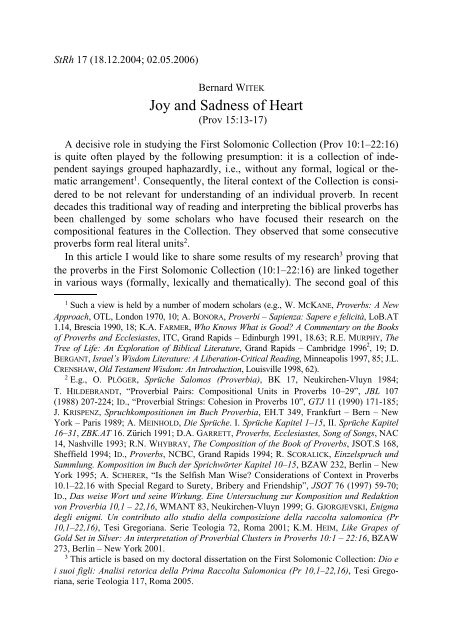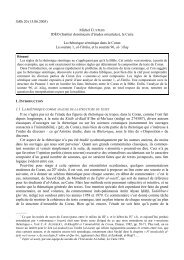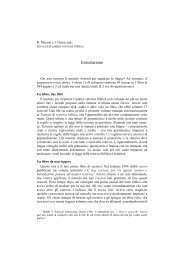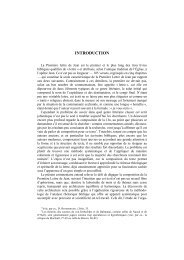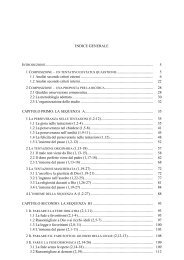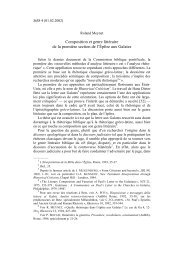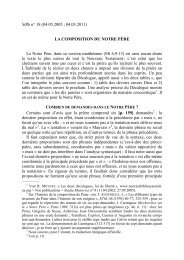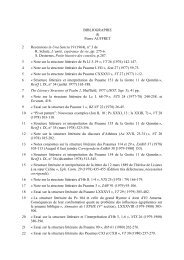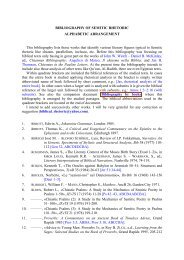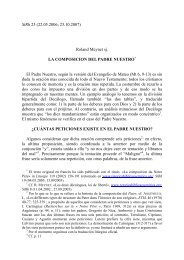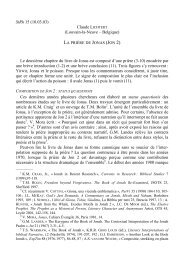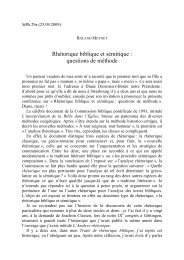Joy and Sadness of Heart - Retorica Biblica e Semitica
Joy and Sadness of Heart - Retorica Biblica e Semitica
Joy and Sadness of Heart - Retorica Biblica e Semitica
You also want an ePaper? Increase the reach of your titles
YUMPU automatically turns print PDFs into web optimized ePapers that Google loves.
StRh 17 (18.12.2004; 02.05.2006)<br />
Bernard WITEK<br />
<strong>Joy</strong> <strong>and</strong> <strong>Sadness</strong> <strong>of</strong> <strong>Heart</strong><br />
(Prov 15:13-17)<br />
A decisive role in studying the First Solomonic Collection (Prov 10:1–22:16)<br />
is quite <strong>of</strong>ten played by the following presumption: it is a collection <strong>of</strong> independent<br />
sayings grouped haphazardly, i.e., without any formal, logical or thematic<br />
arrangement 1 . Consequently, the literal context <strong>of</strong> the Collection is considered<br />
to be not relevant for underst<strong>and</strong>ing <strong>of</strong> an individual proverb. In recent<br />
decades this traditional way <strong>of</strong> reading <strong>and</strong> interpreting the biblical proverbs has<br />
been challenged by some scholars who have focused their research on the<br />
compositional features in the Collection. They observed that some consecutive<br />
proverbs form real literal units 2 .<br />
In this article I would like to share some results <strong>of</strong> my research 3 proving that<br />
the proverbs in the First Solomonic Collection (10:1–22:16) are linked together<br />
in various ways (formally, lexically <strong>and</strong> thematically). The second goal <strong>of</strong> this<br />
1 Such a view is held by a number <strong>of</strong> modern scholars (e.g., W. MCKANE, Proverbs: A New<br />
Approach, OTL, London 1970, 10; A. BONORA, Proverbi – Sapienza: Sapere e felicità, LoB.AT<br />
1.14, Brescia 1990, 18; K.A. FARMER, Who Knows What is Good? A Commentary on the Books<br />
<strong>of</strong> Proverbs <strong>and</strong> Ecclesiastes, ITC, Gr<strong>and</strong> Rapids – Edinburgh 1991, 18.63; R.E. MURPHY, The<br />
Tree <strong>of</strong> Life: An Exploration <strong>of</strong> <strong>Biblica</strong>l Literature, Gr<strong>and</strong> Rapids – Cambridge 1996 2 , 19; D.<br />
BERGANT, Israel’s Wisdom Literature: A Liberation-Critical Reading, Minneapolis 1997, 85; J.L.<br />
CRENSHAW, Old Testament Wisdom: An Introduction, Louisville 1998, 62).<br />
2 E.g., O. PLÖGER, Sprüche Salomos (Proverbia), BK 17, Neukirchen-Vluyn 1984;<br />
T. HILDEBRANDT, “Proverbial Pairs: Compositional Units in Proverbs 10–29”, JBL 107<br />
(1988) 207-224; ID., “Proverbial Strings: Cohesion in Proverbs 10”, GTJ 11 (1990) 171-185;<br />
J. KRISPENZ, Spruchkompositionen im Buch Proverbia, EH.T 349, Frankfurt – Bern – New<br />
York – Paris 1989; A. MEINHOLD, Die Sprüche. I. Sprüche Kapitel 1–15, II. Sprüche Kapitel<br />
16–31, ZBK.AT 16. Zürich 1991; D.A. GARRETT, Proverbs, Ecclesiastes, Song <strong>of</strong> Songs, NAC<br />
14, Nashville 1993; R.N. WHYBRAY, The Composition <strong>of</strong> the Book <strong>of</strong> Proverbs, JSOT.S 168,<br />
Sheffield 1994; ID., Proverbs, NCBC, Gr<strong>and</strong> Rapids 1994; R. SCORALICK, Einzelspruch und<br />
Sammlung. Komposition im Buch der Sprichwörter Kapitel 10–15, BZAW 232, Berlin – New<br />
York 1995; A. SCHERER, “Is the Selfish Man Wise? Considerations <strong>of</strong> Context in Proverbs<br />
10.1–22.16 with Special Regard to Surety, Bribery <strong>and</strong> Friendship”, JSOT 76 (1997) 59-70;<br />
ID., Das weise Wort und seine Wirkung. Eine Untersuchung zur Komposition und Redaktion<br />
von Proverbia 10,1 – 22,16, WMANT 83, Neukirchen-Vluyn 1999; G. GJORGJEVSKI, Enigma<br />
degli enigmi. Un contributo allo studio della composizione della raccolta salomonica (Pr<br />
10,1–22,16), Tesi Gregoriana. Serie Teologia 72, Roma 2001; K.M. HEIM, Like Grapes <strong>of</strong><br />
Gold Set in Silver: An interpretation <strong>of</strong> Proverbial Clusters in Proverbs 10:1 – 22:16, BZAW<br />
273, Berlin – New York 2001.<br />
3 This article is based on my doctoral dissertation on the First Solomonic Collection: Dio e<br />
i suoi figli: Analisi retorica della Prima Raccolta Salomonica (Pr 10,1–22,16), Tesi Gregoriana,<br />
serie Teologia 117, Roma 2005.
2<br />
BERNARD WITEK<br />
article is to point out how the interpretation <strong>of</strong> the proverbs within the literary<br />
units can give a new light to their underst<strong>and</strong>ing.<br />
Five consecutive proverbs (15:13-17) are chosen as an example <strong>of</strong> a well delimited<br />
<strong>and</strong> organized literal unit. In the Collection it is located in the central sequence<br />
(14:23–17:20) as one <strong>of</strong> seven passages <strong>of</strong> its initial subsequence (14:23–<br />
15:24) 4 .<br />
TEXT<br />
13 A joyful heart 5 makes a glad face,<br />
but by the sorrow <strong>of</strong> heart the spirit (is) broken.<br />
14 <strong>Heart</strong> <strong>of</strong> an intelligent searches knowledge,<br />
but the face 6 <strong>of</strong> fools feeds 7 on folly.<br />
4 According to my proposal the entire First Solomonic Collection (10:1–22:16) is composed<br />
<strong>of</strong> five major units (10:1–12:28; 13:1–14:22; 14:23–17:20; 17:21–20:8; 20:9–22:16) that I call<br />
“sequences”. The central sequence (14:23–17:20) is divided into three subsequences (14:23–<br />
15:24; 15:25–16:16; 16:17–17:20). Regarding the first subsequence (14:23–15:24), it contains<br />
seven passages (14:23-27; 14:28-34; 14:35–15:4; 15:5-7; 15:8-12; 15:13-17; 15:18-24).<br />
A<br />
10,1–12,28<br />
B<br />
13,1–14,22<br />
C<br />
14,23–17,20<br />
B’<br />
17,21–20,8<br />
A B A’<br />
14:23–15:24 15:25–16:16 16:17–17:20<br />
A’<br />
20,9–22,16<br />
A B C D C’ A’ B’<br />
14:23-27 14:28-34 14:35–15:4 15:5-7 15:8-12 15:13-17 15:18-24<br />
5 Respecting the word order in the original text the translation should be “a heart <strong>of</strong> joy”.<br />
The literal translation will be used in the figure where it is relevant for the composition.<br />
6 Many scholars follow the qere ûpî “but the mouth” (e.g.: A. BARUCQ, Le Livre des<br />
Proverbes, SBi, Paris 1964, 134; W. BÜHLMANN, Vom rechten Reden und Schweigen. Studien<br />
zu Proverbien 10–31, OBO 12, Göttingen 1976, 190; F. DELITZSCH, “Proverbs”, in C.F. KEIL<br />
– F. DELITZSCH, Commentary on the Old Testament, VI. Proverbs, Ecclesiastes, Song <strong>of</strong><br />
Songs, Peabody 1966, 233; B. GEMSER, Sprüche Salomos, HAT 16, Tübingen 1963 2 , 68;<br />
W.O.E. OESTERLEY, The Book <strong>of</strong> Proverbs, WC, London 1929, 121; P.A. STEVESON, A<br />
Commentary on Proverbs, Greenville 2001, 206, n. 7). The ketib, ûp e nê “but the face,” could<br />
be retained by the following reasons: a) The word pānîm is used in the previous verse (13a);<br />
b) It is not unusual to find a subject in plural accompanied by a verb in singular (K.M. HEIM,<br />
Like Grapes, 197). M. DAHOOD defends the ketib <strong>and</strong> suggests on the basis <strong>of</strong> the Ugaritic<br />
texts that the term p e nê could have the meaning <strong>of</strong> “desire, appetite” (Proverbs <strong>and</strong> Northwest
JOY AND SADNESS OF HEART 3<br />
15 All the days <strong>of</strong> the indigent (are) evil,<br />
but <strong>of</strong> the cheerful heart (are) a feast without end 8 .<br />
16 Better a little with the fear <strong>of</strong> the Lord,<br />
than great treasure <strong>and</strong> anxiety with it.<br />
17 Better a dish <strong>of</strong> herbs where (is) love,<br />
than a fattened ox <strong>and</strong> hate with it.<br />
COMPOSITION<br />
The passage is composed <strong>of</strong> three pieces (13-14, 15, 16-17) organized in<br />
concentric manner 9 . Both segments <strong>of</strong> the initial piece (13-14) begin with the<br />
Semitic Philology, SPIB 113, Roma 1963, 34). The ketib is retained also by G. KUHN,<br />
Beiträge zur Erklärung des salomonischen Spruchbuches, BWANT 16, Stuttgart 1931, 37.<br />
7 There are two homonyms <strong>of</strong> the verb r‘h. Many prefer the first one meaning “pasture,<br />
graze” (e.g.: W. BÜHLMANN, Vom rechten Reden, 190-191; W.O.E. OESTERLEY, The Book <strong>of</strong><br />
Proverbs, 121; R.B.Y. SCOTT, Proverbs. Ecclesiastes, AncB 18, Doubleday 1965, 101; A.<br />
SCHERER, Das weise Wort, 165; R.N. WHYBRAY, Proverbs, 230). If the second would taken<br />
r‘h “be associated with”, it could indicate that “the speech <strong>of</strong> fools consorts with folly” (W.<br />
MCKANE, Proverbs, 479). According to J.H. GREENSTONE, both meanings are possible<br />
(Proverbs, Philadelphia 1950, 164). Some prefer to read r‘h with the meaning <strong>of</strong> the<br />
homonym Aramaic verb “desire, pleasure” (W. FRANKENBERG, Die Sprüche, HK 3/1,<br />
Göttingen 1898, 92; M. STUART, Commentary on the Book <strong>of</strong> Proverbs, New York 1859,<br />
283). D.W. THOMAS for the parallelism suggests to read yid‘eh “he seeks” (“Textual <strong>and</strong><br />
Philological Notes on Some Passages in the Book <strong>of</strong> Proverbs”, in M. NOTH – D.W. THOMAS,<br />
ed., Wisdom in Israel <strong>and</strong> in the Near East, Fs. H.H. Rowley, VT.S 3, Leiden 1955, 285).<br />
8 It could be a case <strong>of</strong> ellipsis. Consequently the expression kol y e mê “all the days” should<br />
apply also do the second stich <strong>and</strong> the expression tôb lēb “cheerful heart” will be an object <strong>of</strong><br />
kol y e mê as ‘ānî “the indigent” in the first stich (F. HITZIG, Die Sprüche Salomo’s, Zürich<br />
1858, 150; A. MEINHOLD, Die Sprüche. I, 253-254; W.A. VAN DER WEIDEN, Le Livre des<br />
Proverbes. Notes philologiques, BibOr 23, Roma 1970, 115). Therefore the MT does not<br />
require the following amendments: l e tôb lēb “for a cheerful heart” (BHS; A. MÜLLER – A.<br />
KAUTZSCH, The Book <strong>of</strong> Proverbs. Critical Edition <strong>of</strong> the Hebrew Text, Leipzig – Baltimore –<br />
London 1901, 48; C.H. TOY, A Critical <strong>and</strong> Exegetical Commentary on the Book <strong>of</strong> Proverbs,<br />
ICC, Edinburgh 1899, Reprint 1988, 312) <strong>and</strong> tûb lēb “cheerful heart” (B. GEMSER, Sprüche<br />
Salomos, 69; J. KRISPENZ, Spruchkompositionen, 71). The expression tôb lēb is translated in<br />
various ways: “good soul” (W. FRANKENBERG, Die Sprüche, 93), “happy heart” (V. HAMP,<br />
Das Buch der Sprüche, EB, Würzburg 1949, 43), “joyful heart” (A. BARUCQ, Le Livre, 134),<br />
“gladness in heart” (A. VACCARI, “I Proverbi”, La Sacra Bibbia, V. I Libri poetici, Firenze<br />
1949, 48) <strong>and</strong> “optimist” (A. LELIÈVRE – A. MAILLOT, Commentaire des Proverbes. I. Les<br />
Proverbes de Salomon, chapitres 10-18, LeDiv Commentaires 1, Paris 1993, 170).<br />
9 Some scholars (W.G. PLAUT, Book <strong>of</strong> Proverbs: A Commentary, New York 1961, 171;<br />
O. PLÖGER, Sprüche, 182; R.C. VAN LEEUWEN, “The Book <strong>of</strong> Proverbs”, in The New<br />
Interpreter’s Bible, V, Nashville 1997, 149-150; R.J. CLIFFORD, Proverbs: A Commentary,<br />
OTL, Louisville 1999, 152) recognize the same limits <strong>of</strong> the unit observing the presence <strong>of</strong> the<br />
keywords: lēb “heart” (13a, 14a, 15b) <strong>and</strong> tôb rendered in the translation by “cheerful” (15b)<br />
<strong>and</strong> “better” (16a <strong>and</strong> 17a). However, non <strong>of</strong> these have noted that the composition <strong>of</strong> the unit is<br />
concentric. A. SCHERER also acknowledges the possibility <strong>of</strong> such a delimitation <strong>of</strong> the unit,
4<br />
BERNARD WITEK<br />
same Hebrew word lēb “heart” (13a <strong>and</strong> 14a) used in a positive context: “the<br />
heart <strong>of</strong> joy” (13a) <strong>and</strong> “the heart <strong>of</strong> an intelligent” (14a). When in 14b the word<br />
ketib is followed by the term pāneh “face” (13a <strong>and</strong> 14b) then it receives a<br />
double function: a) it establishes an additional link between both proverbs <strong>and</strong><br />
b) it makes an inclusion between the extremities <strong>of</strong> the initial piece (13a <strong>and</strong><br />
14b) 10 .<br />
Both segments <strong>of</strong> the final piece (16-17) are the so-called tôb... min “better...<br />
than” proverbs. The first members begin with the adjective tôb “better” (16a <strong>and</strong><br />
17a), while the second members start with the particle min “than” (16b <strong>and</strong> 17b).<br />
There are yet two other formal features in the second members (16b <strong>and</strong> 17b)<br />
that make these proverbs very similar: a) the third term is preceded by the<br />
conjunction (waw copulativum “<strong>and</strong>”) <strong>and</strong>; b) both sayings are closed with the<br />
expression bô “with it” 11 .<br />
The striking formal parallelism between verses 16 <strong>and</strong> 17 requires that we<br />
should look for some differences between these sayings 12 . Both third terms <strong>of</strong><br />
the second members (16b <strong>and</strong> 17b) at the first sight seem to be the synonyms,<br />
but they in fact are complementary terms. “Anxiety” (16b) indicates the<br />
emotional condition <strong>of</strong> the subject itself, while “hate” (17b) is the reaction <strong>of</strong><br />
others, not <strong>of</strong> the subject. Not only these terms but even both proverbs (16 <strong>and</strong><br />
17) can be seen as complementary statements. Verse 16 regards a relation<br />
between man <strong>and</strong> God, while verse 17 describes interhuman relations. A<br />
negative attitude toward God results in “anxiety” (16b). “Hate” (17b) can be a<br />
human response to someone who is doing injustice.<br />
In the central segment (15) the proper terms <strong>of</strong> the extreme pieces are used:<br />
the noun lēb “heart” (13ab, 14a, 15b) <strong>and</strong> the adjective tôb “cheerful/better”<br />
(15b, 16a, 17a) 13 . They form the following expression: tôb lēb “cheerful heart”<br />
however, he includes also verse 18, because, according to him, it is linked conceptually<br />
(emotions) with verse 17 (Das weise Wort, 172-173). Other similar delimitations: 7-17 (F.<br />
DELITZSCH, “Proverbs”, 230); 11-17 (J. KRISPENZ, Spruchkompositionen, 71-72; H.F. FUHS,<br />
Das Buch der Sprichwörter. Ein Kommentar, FzB 95, Würzburg 2001, 243; ID., Sprichwörter,<br />
neuEB 35, Würzburg 2001, 105); 12-15 <strong>and</strong> 16-17 (D.A. GARRETT, Proverbs, 153); 12-17<br />
(R.N. WHYBRAY, The Composition, 104-105; ID., Proverbs, 229-230); 12-18 (H.-J.<br />
HERMISSON, Studien zur israelitischen Spruchweisheit, WMANT 28, Neukirchen-Vluyn 1968,<br />
178); 13-18 (K.M. HEIM, Like Grapes, 197); 13-19 (A. MEINHOLD, Die Sprüche. I, 253); 15-17<br />
(R.N. WHYBRAY, “Yahweh-sayings <strong>and</strong> their Contexts in Proverbs 10,1–22,16”, in M.<br />
GILBERT, ed., La Sagesse de l’Ancien Testament, BEThL 51, Leuven 1990, 161).<br />
10 See note 6.<br />
11 Out <strong>of</strong> 20 tôb... min proverbs in the Book <strong>of</strong> Proverbs these two sayings belong to the<br />
same group (4 th ) together with 12:9 <strong>and</strong> 16:8 (J. WEHRLE, Sprichwort und Weisheit: Studien<br />
zur Syntax und Semantik der tōb...min-Sprüche im Buch der Sprichwörter, ATSAT 38, St.<br />
Ottilien 1993, 204). For a detailed analysis <strong>of</strong> both proverbs see: Ibid., 35-36 <strong>and</strong> 80-81.<br />
12 For an exposition <strong>of</strong> this rhetorical rule see R. MEYNET, L’analisi retorica, Biblioteca<br />
biblica 8, Brescia 1992, 255.<br />
13 In 13b the verb twb “to be good” is used.
JOY AND SADNESS OF HEART 5<br />
(15b). These terms are placed in a reverse order in respect to the extreme pieces<br />
(13-14 <strong>and</strong> 16-17): the first in order is tôb “good”, a proper term <strong>of</strong> the final<br />
piece (16-17), instead the second is lēb referring back to the initial piece (13-<br />
14) 14 .<br />
+ 13 lēb śāmēah yêtib pānîm<br />
– ûb e ‘ass e bat lēb rûah n e kē’â.<br />
+ 14 lēb nābôn y e baqqeš dā‘at<br />
– ûp e nê k e sîlîm yir‘eh ’iwwelet.<br />
– 15 kol y e mê ‘ānî rā‘îm<br />
+ w e tôb lēb mišteh tāmîd.<br />
+ 16 tôb m e ‘at b e yir’at yhwh<br />
– mē’ôsār rāb ûm e hûmâ bô.<br />
+ 17 tôb ’ăruhat yārāq w e ’ahăbâ šām<br />
– miššôr ’ābûs w e śin’â bô.<br />
This chiastic relation between the center (15) <strong>and</strong> the extreme pieces (13-14<br />
<strong>and</strong> 16-17) is also conformed by the antithesis between “evil days <strong>of</strong> the<br />
indigent” (15a) <strong>and</strong> the “feast without end” (15b). The affirmation <strong>of</strong> 15a is<br />
illustrated in 16b <strong>and</strong> 17b. The “evil days <strong>of</strong> the indigent” (15a) can refer also to<br />
the “sorrow <strong>of</strong> heart” (13b), but this link is weaker than the previous one.<br />
+ 13 The HEART <strong>of</strong> JOY makes a GLAD face,<br />
– but by the SORROW <strong>of</strong> HEART the spirit (is) broken.<br />
+ 14 The HEART <strong>of</strong> an intelligent searches knowledge,<br />
– but the face <strong>of</strong> fools feeds on folly.<br />
– 15 All THE DAYS <strong>of</strong> the indigent (are) EVIL,<br />
+ but <strong>of</strong> the CHEERFUL HEART (are) a FEAST without end.<br />
+ 16 BETTER a little with the fear <strong>of</strong> the Lord,<br />
– than the great treasure <strong>and</strong> ANXIETY with it.<br />
+ 17 BETTER a dish <strong>of</strong> herbs where is LOVE<br />
– than a fattened ox <strong>and</strong> HATE with it.<br />
14 The same phenomenon <strong>of</strong> chiastic relation between the center <strong>and</strong> the extremities I have<br />
observed in some other units <strong>of</strong> the Collection (11:7-11; 14:12-14; 14:23-27; 15:25-33; 16:8-<br />
16; 17:9-15).
6<br />
BERNARD WITEK<br />
On the other h<strong>and</strong>, the “feast without end” (15b) goes back to the initial<br />
affirmation “the heart <strong>of</strong> joy makes a glad face” (13a). There is yet relation<br />
between the “feast without end” (15b) <strong>and</strong> the condition <strong>of</strong> a poor man who<br />
enjoys “love” (17a). Again the last link is less evident because lexically both<br />
affirmation (15b <strong>and</strong> 17a) have nothing in common <strong>and</strong> they seem to describe<br />
two opposite situations <strong>of</strong> the wealthy <strong>and</strong> the poor. Nonetheless, besides the<br />
apparent contradiction both members can refer to the same kind <strong>of</strong> people.<br />
Summing up, it is possible to see a chiastic relation between the central segment<br />
(15) <strong>and</strong> the other proverbs <strong>of</strong> the passage (13-14 <strong>and</strong> 16-17) when only the<br />
stronger links are taken into consideration.<br />
From the thematic point <strong>of</strong> view, the affirmation in the central segment (15)<br />
has a general character, while the outer proverbs (13-14 <strong>and</strong> 16-17) are<br />
concerned with inward disposition <strong>and</strong> concrete behaviors:<br />
Inward disposition <strong>and</strong> behavior 13-14<br />
The days are evil for the afflicted <strong>and</strong> good for cheerful heart 15<br />
Behavior <strong>and</strong> inward disposition 16-17<br />
There is yet one interesting formal element. In the central segment (15) the<br />
order <strong>of</strong> the positive <strong>and</strong> negative members is reversed (negative + positive) in<br />
respect to the extreme pieces (13-14 <strong>and</strong> 16-17) where the order <strong>of</strong> members is:<br />
positive + negative.<br />
In the extreme pieces (13-14 <strong>and</strong> 16-17) can be observed a phonetic feature.<br />
In the initial piece (13-14) the first members begin with the word lēb (13a <strong>and</strong><br />
14a) while in the second members (13b <strong>and</strong> 14b) the assonance is between ûb e<br />
(13b) <strong>and</strong> ûp e (14b). In the final piece (16-17) the first members begin with the<br />
term tôb (16a <strong>and</strong> 17a) <strong>and</strong> the initial terms <strong>of</strong> the second members (16b <strong>and</strong><br />
17b) begin with the same letter mem: mē’ôsār (16b) <strong>and</strong> miššôr (17b). In the<br />
central segment (15) the initial terms <strong>of</strong> the members do not produce a similar<br />
sound 15 . Therefore the central proverb differs even phonetically from the rest <strong>of</strong><br />
the passage.<br />
BIBLICAL CONTEXT<br />
Equilibrium in possessing material things<br />
The riches accumulated unjustly (16b) do not help <strong>and</strong> sometimes they ruin<br />
the human relation (16b <strong>and</strong> 17b). The proverbs speak about it: “Better a dry<br />
morsel <strong>and</strong> quietness with it, than a house full <strong>of</strong> feasting with strife” (17:1).<br />
Another proverb suggests that “better a little with righteousness, than a large<br />
income without justice” (16:8). The psalmist expresses the same idea: “Better a<br />
little <strong>of</strong> the just than the abundance <strong>of</strong> many wicked” (Ps 37:16). There is yet<br />
15 Graphically, someone may say that verse 15b begins with the same Hebrew letter waw<br />
like verses 13b <strong>and</strong> 14b but w e (15b) sounds differently than û (13b <strong>and</strong> 14b).
JOY AND SADNESS OF HEART 7<br />
another negative aspect <strong>of</strong> the riches that a wealthy person may be led to deny<br />
God because <strong>of</strong> economical self-sufficiency. In order to avoid such a temptation,<br />
Agur is asking God: “keep lies <strong>and</strong> false words far from me; give me neither<br />
poverty nor riches; feed me with the food that is needed for me” (Prov 30:8). His<br />
last phrase calls to mind the central invocation <strong>of</strong> the Lord’s Prayer: “give us our<br />
daily bread” (Matt 6:11) 16 .<br />
Countenance is the mirror <strong>of</strong> the soul<br />
The affirmation <strong>of</strong> the initial proverbs (13) that the face expression reflects<br />
inward feelings is describes by Ben Sirach in the following way: “The heart<br />
changes the countenance, either for good or for evil. The sign <strong>of</strong> a happy heart is<br />
a cheerful face” (13:25-26a). For Ben Sirach true happiness is a characteristic <strong>of</strong><br />
the heart <strong>of</strong> a just <strong>and</strong> pure person: “Happy are those who do not blunder with<br />
their lips, <strong>and</strong> need not suffer remorse for sin. Happy are those whose hearts do<br />
not condemn them, <strong>and</strong> who have not given up their hope” (14:1-2). His words<br />
evoke one <strong>of</strong> the gospel beatitudes: “Blessed are the pure <strong>of</strong> heart, for they will<br />
see God” (Matt 5:8). On the other h<strong>and</strong>, the fallen countenance <strong>of</strong> Cain (Gen<br />
4:6-7) is a sign <strong>of</strong> his wicked attitude against his brother Abel.<br />
INTERPRETATION<br />
Cheerful heart’s joy<br />
The expression tôb lēb “cheerful heart” (15b) taken by itself is enigmatic <strong>and</strong><br />
can be understood in various ways. Within the proverbs (15) a “cheerful<br />
hearted” person is opposed to an “indigent” (15a) <strong>and</strong> it would indicate someone<br />
who is rich. In the light <strong>of</strong> the initial piece (13-14) a “cheerful hearted” person<br />
(15b) can be characterized as joyful (13a) <strong>and</strong> intelligent (14a). The initial<br />
assertion (13) is based on observation that emotions <strong>and</strong> feelings naturally tend<br />
to make themselves visible. The expression “cheerful heart” (15b) can indicate<br />
various positive emotions <strong>and</strong> feelings <strong>and</strong> one <strong>of</strong> them can be “joy” (13a). It<br />
could be deduced from the central proverbs (15) because the days <strong>of</strong> “the<br />
cheerful heart” person are “a feast without end” (15b) <strong>and</strong> a visible sign <strong>of</strong><br />
internal joy is a joyful countenance (13a). The second characteristic <strong>of</strong> a<br />
“cheerful heart” person (15b) is “intelligence” (14a). Searching for “knowledge”<br />
(14a), being opposed to the attitude <strong>of</strong> the fools that satisfy themselves with<br />
folly (14b), suggests that a wise person does not accept just any kind <strong>of</strong><br />
nourishment but is searching for a proper one. A contrast between “searching”<br />
(14a) <strong>and</strong> “feeding themselves” (14b) can indicate effort <strong>and</strong> dedication on the<br />
one h<strong>and</strong> (14a) <strong>and</strong> passivity <strong>and</strong> laziness on the other h<strong>and</strong> (14b). An intelligent<br />
16 For the composition <strong>of</strong> the Lord’s Prayer (Matt 6:9-13) <strong>and</strong> the central function <strong>of</strong> the<br />
fourth invocation (v. 11) see R. MEYNET, “E ora, scrivete per voi questo cantico”. Introduzione<br />
pratica all’analisi retorica, 1. Detti e proverbi, ReBib 3, Roma 1996, 15-16; ID., “La<br />
composition du Notre Père”, Liturgie 119 (2002) 158-191.
8<br />
BERNARD WITEK<br />
person is ready to make sacrifices wanting to obtain what is valuable (14a),<br />
while the fools satisfy themselves with “folly” that does not require any effort to<br />
get it (14b).<br />
Searching for “knowledge” (14a) can be read also in the light <strong>of</strong> the initial<br />
affirmation <strong>of</strong> the final piece that suggests a modest life “with the fear <strong>of</strong> the<br />
Lord” (16a). The Book <strong>of</strong> Proverbs states that the fear <strong>of</strong> the Lord is a source <strong>of</strong><br />
knowledge <strong>and</strong> wisdom (cf. 1:7). Searching for knowledge (15:14a) can imply a<br />
respectable <strong>and</strong> obedient attitude toward God <strong>and</strong> His comm<strong>and</strong>ments (16a). A<br />
wise person tries to underst<strong>and</strong> God’s teaching <strong>and</strong> to live in conformity to it<br />
(14a). Therefore his/her preference is to be pleasing to God <strong>and</strong> respect his<br />
teaching (16a) instead <strong>of</strong> having great riches gained unjustly (16b). Searching<br />
for “knowledge” like for a valuable thing (14a) can imply also a preference for<br />
having a good relation with the other, <strong>of</strong> being loved <strong>and</strong> respected (17a),<br />
instead <strong>of</strong> having great riches that result in hate, envy <strong>and</strong> division (17b).<br />
The “cheerful hearted” person (15b) is “an intelligent” person (14a) who<br />
enjoys life (13a) even if from an economical point <strong>of</strong> view he/she might be poor<br />
(16a <strong>and</strong> 17a). For a wise person a valuable thing (14a) <strong>and</strong> true joy (13a) is to<br />
live in peace with God (16a) <strong>and</strong> others (17a).<br />
<strong>Sadness</strong> <strong>of</strong> the fool<br />
The name “indigent” (15a) in the passage does not seem to indicate a material<br />
poverty but rather a spiritual indigence because <strong>of</strong> deprivation <strong>of</strong> characteristics<br />
proper to the “cheerful heart” person (15b) described above. Now a “broken<br />
spirit” (13b) <strong>and</strong> “anxiety” (16b) take the place <strong>of</strong> “joy” (13a) <strong>and</strong> intelligence<br />
(14a).<br />
The expression “the face <strong>of</strong> fools feeds on folly” (14b) is somehow enigmatic,<br />
but when it is read in the light <strong>of</strong> the final piece (16-17) then it can express that<br />
relying upon material things (16b <strong>and</strong> 17b) is foolishness because they do not<br />
satisfy the inward <strong>and</strong> spiritual needs. Unfortunately the fools (14b) do not<br />
underst<strong>and</strong> it <strong>and</strong> most probably they become rich in an unjust way, because <strong>of</strong><br />
their lack <strong>of</strong> respect toward God implies also a lack <strong>of</strong> respect toward His<br />
teachings <strong>and</strong> His comm<strong>and</strong>ments (cf. 16a). Such treasures cannot give them<br />
true happiness (cf. 13b <strong>and</strong> 15b). In the divine dimension an unjust gain results<br />
in restlessness <strong>of</strong> heart <strong>and</strong> in guilt (16b), while in the human dimension it<br />
causes hate, envy <strong>and</strong> division (17b).<br />
CONCLUSION<br />
The passage is a well organized literary unit from the formal as well as the<br />
lexical <strong>and</strong> thematic points <strong>of</strong> view. It demonstrates the features that are<br />
common to some other units <strong>of</strong> the First Solomonic Collection (10:1–22:16).<br />
The central segment (15) shows some peculiarities. Thematically, it expresses
JOY AND SADNESS OF HEART 9<br />
the more general idea than the extreme pieces (13-14 <strong>and</strong> 16-17) 17 . Lexically,<br />
besides the use <strong>of</strong> the keywords lēb “heart” (13a, 14a, 15b) <strong>and</strong> tôb “good” (15b,<br />
16a, 17a), the central proverb (15) seems to be only loosely connected with the<br />
outer pieces (13-14 <strong>and</strong> 16-17). However, the lexical discontinuity between the<br />
central segment (15) <strong>and</strong> other segment (13-14 <strong>and</strong> 16-17) is only apparent<br />
because the proverbs are linked conceptually. Formally, in the central segment<br />
(15) the order <strong>of</strong> the positive <strong>and</strong> negative members is reversed in confrontation<br />
to other segments (13-14 <strong>and</strong> 16-17). Also a chiastic relation has been noted<br />
between the centre (15) <strong>and</strong> the rest <strong>of</strong> the passage (13-14 <strong>and</strong> 16-17) 18 .<br />
© Studia Rhetorica<br />
[18.12.2004]<br />
[last up to date: 02.05.2006]<br />
17 The same phenomenon is observed in other passages, for example in 11:12-16 <strong>and</strong><br />
14:23-27.<br />
18 See n. 14.


